Siqueiros in the University City: street murals
From 1932 onwards, Siqueiros produced two types of mural cycles: the cubic space interiors, called by him "harmonic machines"; and the exterior murals understood as street billboards. Check them out.

In 1950, David Alfaro Siqueiros competed in the 25th Venice Biennial. The jury awarded the first international prize to the French painter Henri Matisse and the Italian painter Carlo Carrà, with whom the muralist established a close friendship in his youth. The second international prize was awarded to Siqueiros, who also received the First Prize Brazil, on loan from the Museum of Modern Art of Sao Paulo.
The Mexican artist declared to the press: "I am happy to receive this award because it means the recognition, in Europe, of our modern pictorial movement. I will use this money to modernize, with ultramodern and mechanical technology, my experimental collective painting workshop, to put it at the service of young painters who do not have sufficient resources to practice their art".
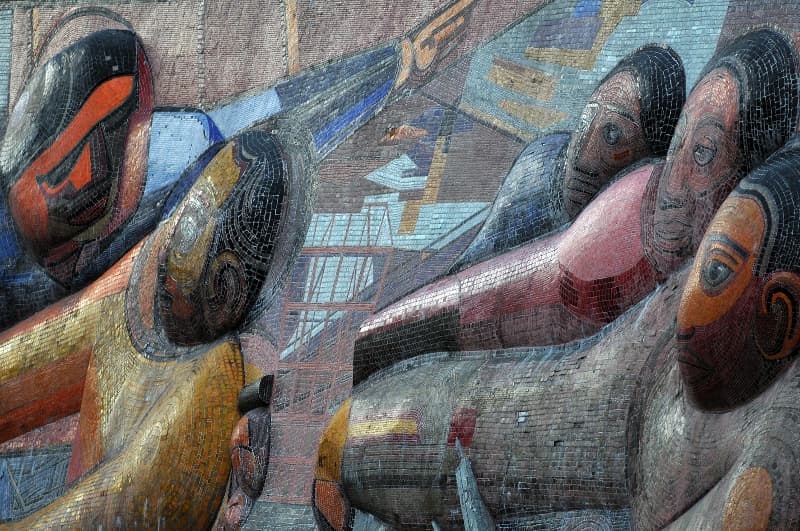
Political Commitment
The political commitment of the artist was not enough to achieve militant avant-garde art. To be an artist of his era, he had to master an expressive technique of the technical and scientific discoveries of his time; to carry out experimental processes and change the mechanisms of artistic production.
It was necessary to make an art that was included in the industrial era, integrated not only into the Fine Arts but also into the languages of the new industrial media. To amass revolution corresponded a mass art. To a highly technological world, an art of technical excellence, of experimental innovation.
From 1932 onwards, Siqueiros produced two types of mural cycles: the cubic space interiors, called by him "harmonic machines"; and the exterior murals understood as street billboards.
The large advertisements, and the street billboards, were one of the examples to follow for Siqueiros, who, in 1952, when he was painting the exterior mural cycle of Ciudad Universitaria (University City), confirmed that "there is only one valid experience before our current muralist effort towards the street: that of commercial propaganda, the poster that covers the large uncovered walls of the cities, industrially and commercially important of our time".
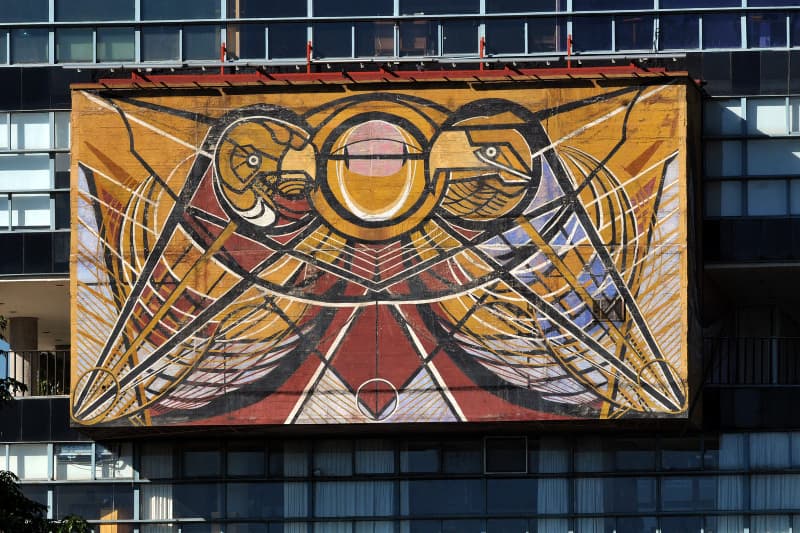
In 1932, Siqueiros painted three outdoor murals in Los Angeles, California, using materials and tools from the construction industry. In these murals, he integrated the languages of cinema and Disney animation into the pictorial language. For these innovative contributions, he is considered the father of street muralism.
"The artists of his different periods were never satisfied with the means of their predecessors, being, on the contrary, the most assiduous seekers and discoverers of new procedures" - David Alfaro Siqueiros
Initially, the muralists were not invited to paint murals on the brand new architecture of Ciudad Universitaria. They considered it an affront and a challenge, so they put up a fight and won several walls within that functionalist architecture. For Siqueiros, it was "impossible to imagine the construction of a university city in Mexico today without the inclusion of murals and sculptures [...] integrated into the architecture".
On March 25, 1956, in a full-page article in the newspaper Excélsior, Siqueiros wrote about his mural cycle at the National University: "Exterior muralism is the second stage of muralism. Modern muralism".
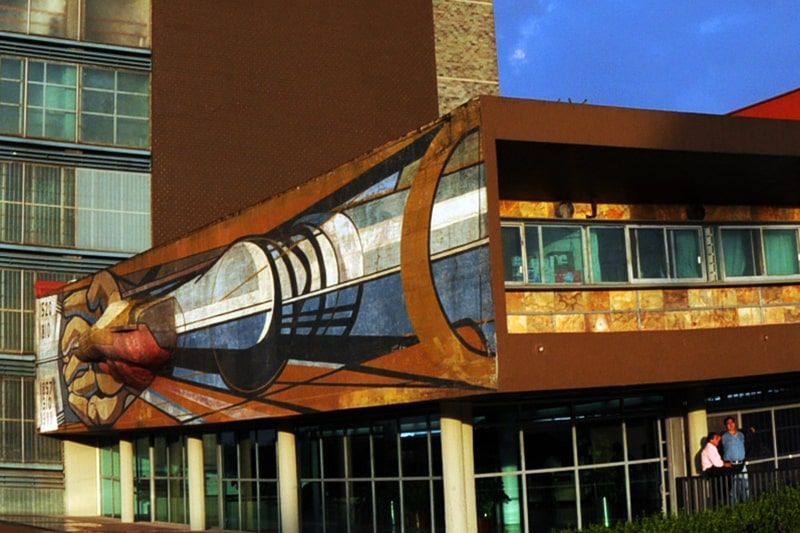
On the exterior of the Rectory, the artist began to paint on four panels with the collaboration of a team of art students, but due to lack of economic resources -one of the most common forms of censorship- he only finished one of these during the government of Adolfo Ruiz Cortines, which he titled as the slogan: The people to the University and the University to the people. For a national neo-humanist culture of universal depth.
The artist expressed that "the theme of the cycle is that of the University at the service of the nation". Siqueiros recalled José Vasconcelos' speech at his inauguration as rector of the National University in 1921: "At this moment," said the philosopher, "I do not come to work for the University, but to ask the University to work for the people.
About this panel, Siqueiros describes that "in the cloth facing south, 300 square meters, the scholar, the sociologist, and the artist, deliver to the nation the fruit of their studies for scientific, technical, agricultural, industrial and cultural application." The composition of this work is a kinetic achievement of the artist, since "it was resolved from the greatest possible number of angles corresponding to the displacement of the passerby". It was intended to be walked on foot and observed in its entirety from a moving automobile.
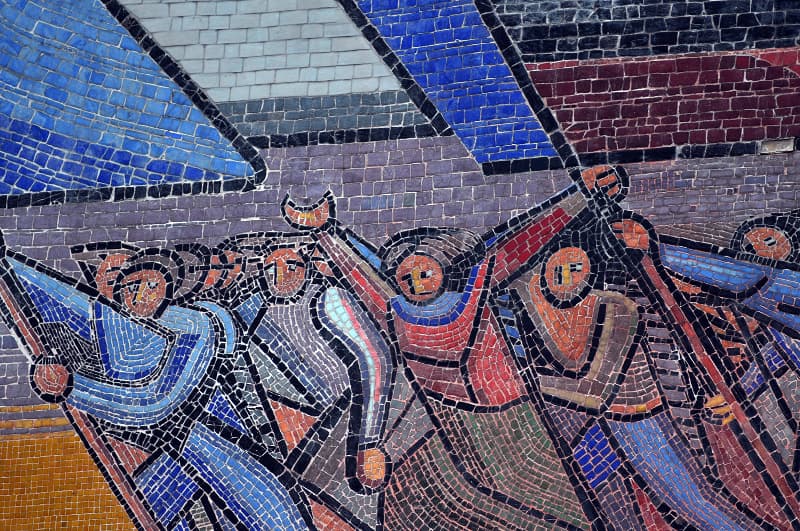
Siqueiros would have liked to have advanced technical means and tools, but his budget was scarce. Therefore, instead of resorting to aluminum, he had to use colored tile "to give form and solidity to the figures".
The exterior mural of Ciudad Universitaria is composed of constructions called by Siqueiros: "Scultopaintings or painted sculptural reliefs, of a schematic character, to be appreciated by spectators on foot and motorized. It is a novel technique that is not sculpture, nor painting, but deep and voluminous colorful reliefs and expressive forms extremely synthesized and dynamic that require a new professional of the arts".
Siqueiros began rehearsing sculpture painting in New York in his experimental workshop of 1936-37 and would practice it extensively both in small paintings and in the gigantic mural cycle of the Polyforum Cultural Siqueiros.
This panel in Ciudad Universitaria was partially restored in the 1990s to prevent damage from temperature changes. In 2017, a new restoration process was started, which has not yet culminated.
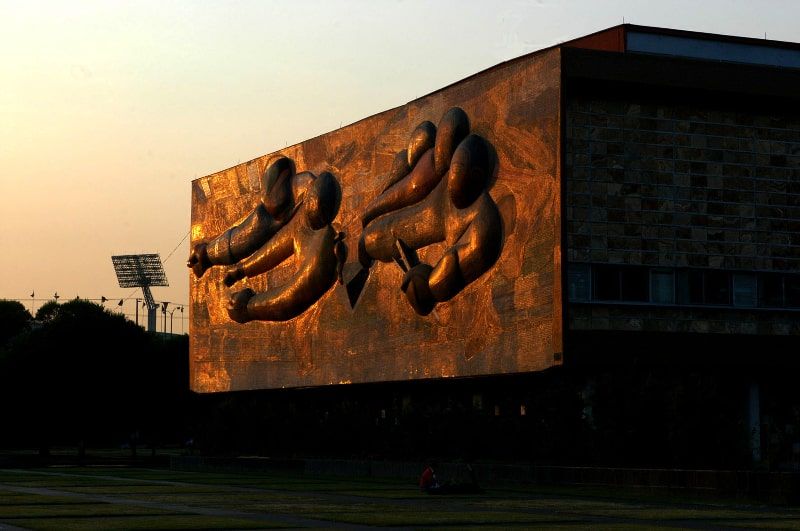
During the UNAM strike in 1999-2000, a group of walkouts untimely threw themselves on another of Siqueiros' panels in the Rectory, with a symbolic title for the university students: The Right to Culture, to repaint one of the dates the artist inscribed there. It is a monumental foreshortening of an arm pointing to five fundamental dates of the country's history: 1520, 1810, 1857, 1910, and 19?
The strikers painted a "99" after erasing the two interrogations left there by the painter. Had Siqueiros reserved this space to certify the event of the proletarian revolution which he calculated would happen before the end of the millennium?
This year 1999 was therefore the time to leave a mark of identity, before the turn of the millennium. The temptation to complete this unknown date has been recurrent and the original is always restored. This irreverence of graffiti artists, paradoxically, has more to do with Siqueiros than the official veneration coupled with the ignorance of his innovative plastic contributions.
By Irene Herner, Source: UNAM Press Bulletin




